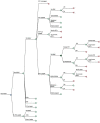Re-Evaluating the Possible Increased Risk of HIV Acquisition With Progestin-Only Injectables Versus Maternal Mortality and Life Expectancy in Africa: A Decision Analysis
- PMID: 29284696
- PMCID: PMC5752605
- DOI: 10.9745/GHSP-D-17-00243
Re-Evaluating the Possible Increased Risk of HIV Acquisition With Progestin-Only Injectables Versus Maternal Mortality and Life Expectancy in Africa: A Decision Analysis
Abstract
Objective: The association between increased risk of HIV acquisition and use of progestin-only injectables (POIs) is controversial. We sought to compare the competing risks of maternal mortality and HIV acquisition with use of POIs using updated data on this association and considering an expanded number of African countries.
Methods: We designed a decision-analytic model to compare the benefits and risks of POIs on the competing risks of maternal mortality and HIV acquisition on life expectancy for women in 9 African countries. For the purposes of this analysis, we assumed that POIs were associated with an increased risk of HIV acquisition (hazards ratio of 1.4). Our primary outcome was life-years and the population was women of reproductive age (15-49 years) in these countries, who did not have HIV infection and were not currently planning a pregnancy. Probabilities for each variable included in the model, such as HIV incidence, access to antiretroviral therapy, and contraceptive prevalence, were obtained from the literature. Univariate and multivariate sensitivity analyses were performed to check model assumptions and explore how uncertainty in estimates would affect the model results.
Results: In all countries, discontinuation of POIs without replacement with an equally effective contraceptive method would result in decreased life expectancy due to a significant increase in maternal deaths. While the removal of POIs from the market would result in the prevention of some new cases of HIV, the life-years gained from this are mitigated due to the marked increase in neonatal HIV cases and maternal mortality with associated life-years lost. In all countries, except South Africa, typical-use contraceptive failure rates with POIs would need to exceed 39%, and more than half of women currently using POIs would have to switch to another effective method, for the removal of POIs to demonstrate an increase in total life-years.
Conclusion: Women living in sub-Saharan Africa cope with both high rates of HIV infection and high rates of pregnancy-related maternal death relative to the rest of the world. Based on the most current estimates, our model suggests that removal of POI contraception from the market without effective and acceptable contraception replacement would have a net negative effect on maternal health, life expectancy, and mortality under a variety of scenarios.
© Rodriguez et al.
Figures

Comment in
-
Modeling Outputs Can Be Valuable When Uncertainty Is Appropriately Acknowledged, but Misleading When Not.Glob Health Sci Pract. 2017 Dec 28;5(4):530-533. doi: 10.9745/GHSP-D-17-00444. Print 2017 Dec 28. Glob Health Sci Pract. 2017. PMID: 29284692 Free PMC article.
References
-
- Joint United Nations Programme on HIV/AIDS (UNAIDS). Prevention Gap Report. Geneva: UNAIDS; 2016http://www.unaids.org/sites/default/files/media_asset/2016-prevention-ga... Accessed November 19, 2017.
Publication types
MeSH terms
Substances
Grants and funding
LinkOut - more resources
Full Text Sources
Other Literature Sources
Medical
